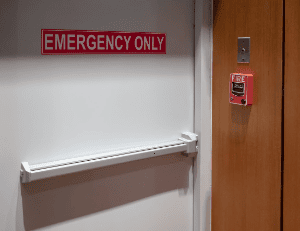
Panic hardware is commonly used on exit doors in commercial buildings. If you haven’t implemented them in your commercial building yet, it’s time to learn more about them. These tips can help you when you purchase and install this essential hardware in your building.
1. Pay Attention to Building Code Requirements
First, be aware of building code requirements when installing panic hardware. You may need to have panic hardware installed on a certain number of exit doors, based on the size and layout of your building. Building code requirements vary from place to place, so consult a building inspector for advice.
When panic hardware is required, you’ll need to follow certain guidelines. The panic hardware should be at least half as wide as the door leaf, for example, and it should be operable with a minimal amount of force. Additionally, you cannot install deadbolts or other additional locks in many cases. Again, ask a building inspector in your area for local advice.
2. Consider Installing More of Them
Even if you are only required to install panic hardware on a certain number of exit doors in your building, you may want to install this hardware on all of your building’s exit doors. Panic hardware is typically affordable, durable and easy to use, making it a good choice even when it’s not required. Plus, having more easy-to-use exits will be handy in case of an emergency.
3. Check Out Your Different Options
Touchpad-style panic bars are the most popular type. They are not your only option, though. If you would prefer a more streamlined, modern look, for example, you can choose the crossbar style. Recessed panic hardware is a good choice when you have limited space around the door area. Assess your company’s needs to choose the best panic hardware.
4. Have Them Professionally Installed
Opt for a professional installation of your panic hardware. If it’s not installed properly, it might not work well. Panic hardware that doesn’t work well can be annoying on the best of days and can put customers and employees in danger in an emergency situation.
Panic hardware that is not installed properly may not stay in place over time, or it could be more prone to wear and tear. With a professional installation, not only can you get advice about which panic hardware to choose, but you can also get help with having panic hardware installed properly.
5. Learn How to Maintain Panic Hardware
Like most things, panic hardware does have to be maintained and repaired from time to time. Luckily, panic hardware is pretty durable and long-lasting. Knowing how to take care of panic hardware and keeping up with maintenance and repairs when needed is important.
The professional who installs your panic hardware should be able to help. Read the manuals and other materials that come with your panic hardware as well to learn about essential maintenance. Then, you will know what to do to keep your hardware in good shape in the long-term.
Typically, maintenance simply involves checking your hardware from time to time. This allows you to ensure that your panic bars work as they are supposed to, such as by opening with the appropriate amount of pressure. You may also need to check the screws and other hardware to ensure that the panic bar is secure, and you can apply lubricant to essential parts when needed.
Installing panic hardware on your commercial exit doors will help you follow local building codes and can save lives in an emergency. Contact us at DuPage Security Solutions Inc. to find out more about panic hardware and other hardware for your commercial doors.